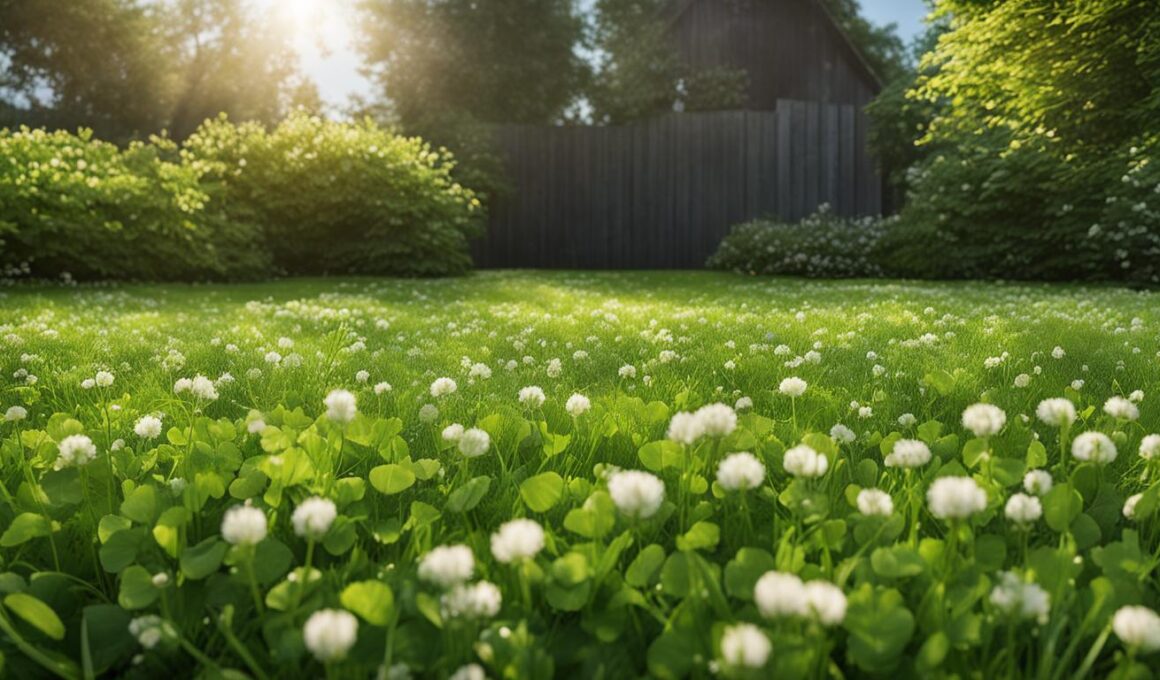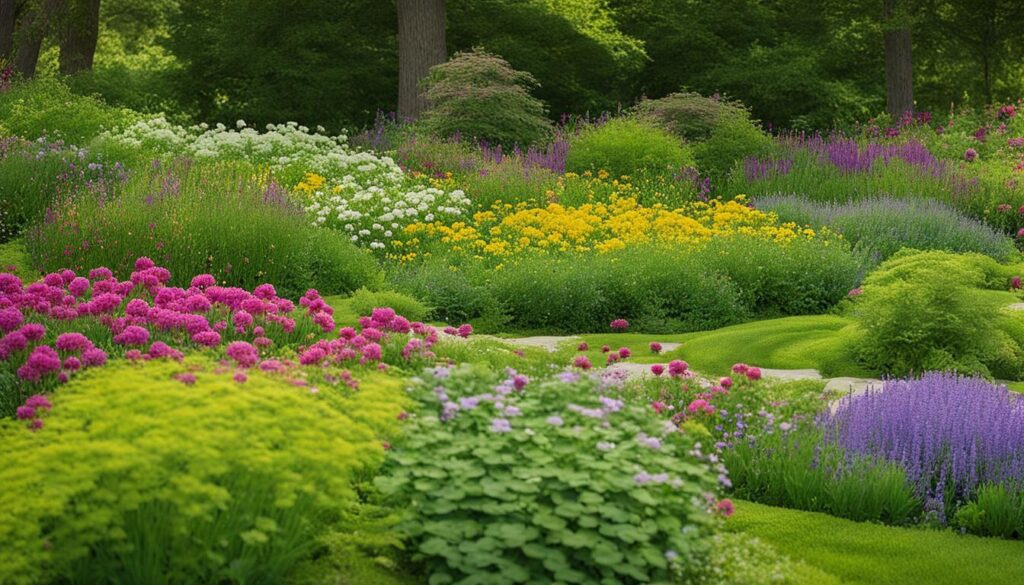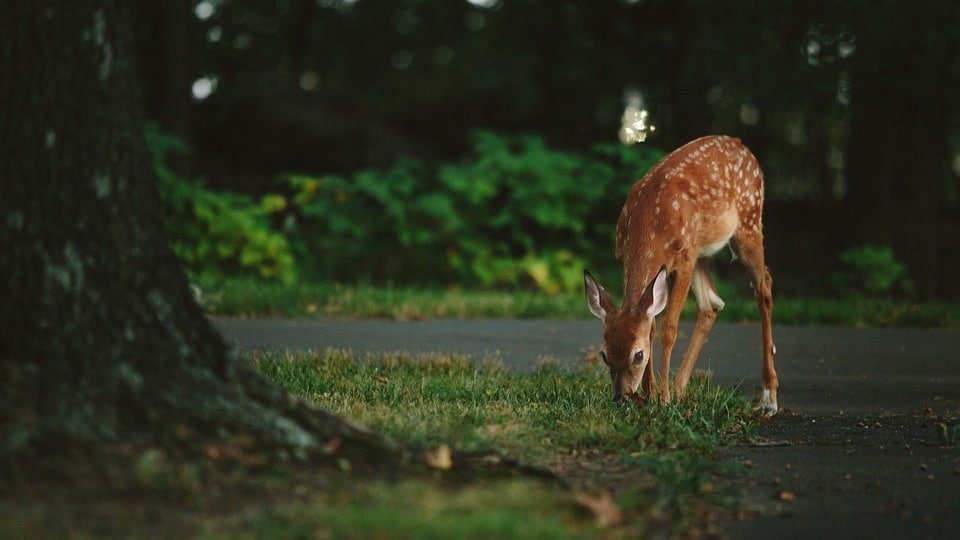Are you looking for a more environmentally friendly alternative to your traditional grass lawn? Planting clover in your existing lawn could be the solution you’ve been searching for. Clover is a tough perennial plant that requires less care and maintenance than grass, while still providing a lush and attractive green lawn. By incorporating clover into your lawn, you can enjoy a beautiful, eco-friendly landscape.
Post Summary
- Planting clover in an existing lawn provides an environmentally friendly alternative to traditional grass.
- Clover lawns require less maintenance and care compared to grass lawns.
- Clover can help improve soil health, reduce water usage, and provide habitat for pollinators.
- Choosing the right clover variety and properly planting and maintaining it are key to a successful clover lawn.
- Consider clover as a temporary solution for renters or in areas with potential lawn redevelopment.
The Rise of Clover Lawns
In recent years, there has been a growing trend towards environmentally friendly lawn alternatives, sparked by concerns about climate change and the decline of pollinator populations. Traditional grass lawns require significant resources, such as water and fertilizer, while providing little value to wildlife. This has led many homeowners to explore alternatives that are more sustainable and beneficial to the environment. One such alternative is the rise of clover lawns.
Clover lawns offer numerous advantages over traditional grass lawns. They require less maintenance, as they grow more slowly and stay greener in dry conditions. Clover is a nitrogen-fixing plant, meaning it can pull nitrogen from the air and convert it into a form that can be utilized by other plants. This reduces the need for additional fertilization, making clover lawns more sustainable and cost-effective. Additionally, clover lawns provide habitat for pollinators like bees and butterflies, supporting their populations and promoting biodiversity.
With the increasing focus on environmental sustainability, clover lawns have become a popular alternative for homeowners. They offer a visually appealing and eco-friendly option that requires less water, fertilizer, and mowing compared to traditional grass lawns. By embracing the rise of clover lawns, homeowners can contribute to a more sustainable future while still enjoying the benefits of a beautiful, green lawn.
“Clover lawns offer numerous advantages over traditional grass lawns. They require less maintenance, are more sustainable, and provide habitat for pollinators like bees and butterflies.”
The Benefits of Clover Lawns
1. Low Maintenance: Clover lawns require less maintenance than grass lawns. They grow more slowly and can tolerate dry conditions, reducing the need for frequent watering. Additionally, clover lawns stay green even without regular mowing, making them an ideal choice for those looking to minimize lawn care.
2. Nitrogen Fixation: Clover is a nitrogen-fixing plant, meaning it can convert nitrogen from the air into a usable form for other plants. This reduces the need for additional fertilization, making clover lawns more environmentally friendly and cost-effective.
3. Weed Suppression: Clover lawns have the ability to suppress weed growth due to their dense and low-growing nature. This reduces the need for herbicides, promoting a healthier and more sustainable lawn.
4. Drought-Resistant: Clover lawns have the advantage of being drought-resistant. Their deep taproots allow them to access water from deeper soil layers, helping them survive periods of dry weather while maintaining their green appearance.
5. Pollinator Habitat: One of the key benefits of clover lawns is their ability to provide habitat for pollinators. The flowers of clover attract bees, butterflies, and other beneficial insects, supporting their populations and promoting biodiversity in your yard.
| Advantages | Traditional Grass Lawns | Clover Lawns |
|---|---|---|
| Maintenance | Requires frequent mowing and watering | Requires less mowing and watering |
| Fertilization | Requires regular fertilization | Nitrogen-fixing properties reduce the need for additional fertilizer |
| Weed Control | May require herbicides to control weed growth | Suppresses weed growth due to its dense nature |
| Drought Resistance | Requires frequent watering to stay green | Tolerates dry conditions and stays green |
| Pollinator Support | Provides little to no habitat for pollinators | Attracts bees, butterflies, and other beneficial insects |
Benefits of Clover Lawns
Clover lawns offer numerous advantages over traditional grass lawns. These low-maintenance alternatives provide a range of benefits that make them an attractive option for homeowners. Let’s explore some of the key advantages of planting a clover lawn:
Natural Nitrogen Fixation
Clover is known for its ability to fix nitrogen in the soil. Through a symbiotic relationship with bacteria in its root system, clover converts nitrogen from the air into a usable form for plants. This natural nitrogen fixation reduces the need for additional fertilization, making clover lawns more environmentally friendly and cost-effective. The nitrogen-rich soil created by clover promotes healthy grass growth and helps to maintain a vibrant, green lawn.
Weed Suppression
Clover lawns have excellent weed suppression properties. The dense growth of clover plants crowds out weeds, preventing them from establishing a foothold in your lawn. This means you’ll spend less time and effort battling pesky weeds, allowing you to enjoy a cleaner, more attractive lawn. Additionally, the presence of clover flowers and foliage can attract beneficial insects that prey on garden pests, further helping to control weed populations.
Drought-Resistant and Low-Maintenance
Clover lawns are highly drought-resistant and require minimal watering to thrive. Unlike traditional grass lawns, which often require frequent and heavy irrigation, clover can withstand dry conditions and retain its green color. This makes clover lawns an ideal choice for regions with limited access to water or for homeowners looking to minimize their water usage. Additionally, clover lawns have a slower growth rate than grass, reducing the need for frequent mowing and overall maintenance.
| Benefits of Clover Lawns |
|---|
| Natural nitrogen fixation |
| Weed suppression |
| Drought-resistant and low-maintenance |
By choosing a clover lawn, you can enjoy these benefits while creating a beautiful, eco-friendly landscape. The natural nitrogen fixation, weed suppression, and low-maintenance characteristics of clover make it an attractive alternative to traditional grass lawns.
Embrace the beauty and practicality of clover in your lawn, and reap the rewards of a vibrant, sustainable outdoor space.
Choosing the Right Clover for Your Lawn
When it comes to choosing the right clover for your lawn, there are a few options to consider. The most common variety is white clover, specifically the Trifolium repens species. This type of clover has deep green leaves and grows close to the ground, making it a popular choice for lawns. Another option is red clover, which tends to grow taller and has a slightly different appearance. Both white and red clover provide numerous benefits, so the choice ultimately depends on your personal preference and the specific conditions of your lawn.
For those looking for a specialty variety, micro-clover is a great option. Micro-clover is a smaller and more compact version of white clover, offering all the same benefits in a smaller package. This variety stays shorter and can blend seamlessly with grass to give your lawn a more uniform look. Micro-clover is particularly popular for golf courses and sports fields due to its ability to withstand heavy foot traffic.
When deciding on the right clover for your lawn, it’s essential to consider your local conditions. Each type of clover may perform differently depending on factors such as climate, soil type, and sunlight exposure. Consulting with your local extension office or a professional landscaper can ensure that you choose the clover variety that will thrive in your specific area.
Comparing Clover Varieties
| Clover Variety | Appearance | Growth Height | Main Benefits |
|---|---|---|---|
| White Clover (Trifolium repens) | Deep green leaves | Low to the ground | – Low maintenance |
| Red Clover (Trifolium pratense) | Lighter green leaves | Taller than white clover | – Nitrogen fixation in soil |
| Micro-Clover | Smaller leaves | Low to the ground | – Improved soil health |
In summary, choosing the right clover variety for your lawn involves considering factors such as appearance, growth height, and specific benefits. While white clover is the most common choice, red clover and micro-clover offer unique advantages depending on your preferences. Remember to take into account your local conditions to ensure the success of your clover lawn.
How to Plant Clover in an Existing Lawn
Planting clover in an existing lawn is a simple process that can help you achieve a lush, eco-friendly lawn. Here are the steps to follow:
- Dethatch the lawn: Start by dethatching the lawn to remove any dead grass or debris and expose the soil. This can be done using a dethatching rake or a mechanical dethatcher.
- Seeding: Lightly sprinkle clover seeds across the prepared lawn. You can do this by hand or use a hand-powered seed spreader. It’s important not to apply the seeds too heavily as clover grows fast and will quickly fill in the gaps.
- Topsoil: Sprinkle a little topsoil over the seeds, enough to cover them but not the grass. This will help the seeds to establish and promote germination.
- Watering: Water the area well after seeding to ensure that the seeds are moist and can germinate properly. Keep the area consistently moist until the seedlings start to appear in a couple of weeks.
By following these steps, you can successfully plant clover in an existing lawn and enjoy the benefits of a low-maintenance, eco-friendly lawn.
By following these simple maintenance practices, you can ensure the longevity and beauty of your clover lawn. With its low maintenance needs and environmental benefits, a clover lawn is a sustainable and attractive alternative to traditional grass lawns.
Other Ground Cover Options
If clover is not your preferred ground cover option, there are other low-growing plants that can create a more traditional look while still providing habitat for pollinators. These plants offer a variety of textures, colors, and growth habits, allowing you to choose the best fit for your lawn and personal preferences.
Low-Growing Plant Options
- Creeping Thyme: This fragrant plant forms a dense mat of small, aromatic leaves and produces beautiful purple or pink flowers. It is drought-tolerant and can withstand foot traffic, making it an excellent choice for walkways and between stepping stones.
- Creeping Mazus: With its vibrant purple flowers, creeping mazus adds a pop of color to your lawn. This ground cover spreads quickly and thrives in moist conditions. It is perfect for edging borders and filling in gaps between larger plants.
- Creeping Speedwell: Also known as Veronica repens, this evergreen ground cover forms a dense carpet of tiny, round leaves. It produces delicate blue or white flowers in the spring and is well-suited for shady areas and rock gardens.
- Creeping Jenny: This low-growing perennial features trailing stems with round, chartreuse leaves. Creeping jenny thrives in moist soil and is an excellent choice for hanging baskets, rock gardens, or as a ground cover in damp areas.
These are just a few examples of the many low-growing plants available as ground cover alternatives to clover. Before making your selection, consider factors such as sunlight exposure, soil conditions, and maintenance requirements. It’s also essential to choose plants that are native to your region to ensure their success in your lawn.
| Plant | Description | Preferred Growing Conditions |
|---|---|---|
| Creeping Thyme | Dense mat with small, aromatic leaves and purple or pink flowers | Sun to part shade; well-drained soil |
| Creeping Mazus | Rapid spreader with vibrant purple flowers | Sun to part shade; moist soil |
| Creeping Speedwell | Evergreen ground cover with tiny round leaves and blue or white flowers | Part shade to shade; well-drained soil |
| Creeping Jenny | Trailing stems with round, chartreuse leaves | Sun to part shade; moist soil |
As you explore the various options, keep in mind that ground cover plants not only provide aesthetic value but also play a crucial role in supporting pollinators. These low-growing plants offer a source of food and habitat for bees, butterflies, and other beneficial insects, contributing to the health and biodiversity of your garden. By selecting pollinator-friendly ground cover options, you can create a beautiful and eco-friendly landscape.
Considerations for Renters
If you’re a renter looking to improve your lawn but have uncertain plans due to potential redevelopment, there are some temporary solutions that can help you create a more attractive and beneficial outdoor space. One option to consider is planting clover in your existing lawn. Clover can serve as a natural ground cover that not only enhances the appearance of your lawn but also provides numerous benefits.
When choosing clover as a temporary solution, it’s important to be aware of any restrictions or ordinances regarding lawn maintenance in your rental agreement or local area regulations. Some landlords or homeowner associations may have guidelines that specifically address the use of clover or the types of plants allowed in lawns. Before proceeding, be sure to review your rental agreement or consult with your landlord to ensure compliance.
One of the advantages of planting clover in your lawn is its ability to suppress the growth of noxious weeds. Clover has dense foliage that can crowd out common weeds, reducing the need for chemical herbicides. Additionally, clover’s deep root system helps to prevent soil erosion, which is especially important if your lawn is being threatened by potential redevelopment.
Another benefit of clover is its ability to attract pollinators such as bees and butterflies. By creating a habitat for these beneficial insects, you not only contribute to the local ecosystem but also increase the chances of successful pollination for nearby plants. This can be particularly important if you have any flowering plants or a vegetable garden in your rental property.
If you’re unsure about the long-term viability of your lawn due to potential redevelopment plans, planting clover can be a practical and environmentally friendly solution. Not only does it offer temporary visual improvements, but it also provides valuable ecological benefits.
The Symbolism of Four-Leaf Clovers
The four-leaf clover has long been associated with luck and good fortune. This rare find is considered a symbol of luck due to its scarcity and the belief that each leaf represents something special – faith, hope, love, and luck. While the chances of finding a four-leaf clover are slim, stumbling upon one is considered fortunate and can bring a sense of excitement and optimism.
The symbolism of the four-leaf clover dates back centuries. In many cultures, it was believed that carrying or possessing a four-leaf clover would ward off evil spirits and bring good luck. The clover’s association with luck can be traced back to ancient Druids, who believed that the four-leaf clover had magical powers and could help them see fairies and avoid danger.
“Finding a four-leaf clover is like finding a needle in a haystack. It’s a rare and precious discovery that brings joy and hope to those who find it.” – Anonymous
While finding a four-leaf clover is undoubtedly a stroke of luck, having clover growing in your lawn can also be considered fortunate. Clover lawns provide numerous benefits, such as reducing the need for maintenance, improving soil health, and attracting beneficial insects. So, even if you don’t find a four-leaf clover, having clover as part of your landscape can still bring a sense of luck and abundance to your outdoor space.
The Symbolism of Four-Leaf Clovers – Key Takeaways
- The four-leaf clover is a symbol of luck and good fortune.
- Each leaf of a four-leaf clover represents faith, hope, love, and luck.
- Finding a four-leaf clover is considered fortunate due to its rarity.
- Clover lawns provide benefits such as reduced maintenance and increased habitat for beneficial insects.
Other Ground Cover Options
If clover isn’t the right ground cover option for your lawn, there are several hardy plants that you can consider. These plants not only provide durable coverage but can also withstand various conditions, making them ideal choices for different environments.
1. Creeping Thyme
Creeping thyme is a low-growing perennial plant that forms a dense mat of fragrant foliage. It produces small, colorful flowers in shades of pink, lavender, or white, attracting bees and butterflies to your lawn. Creeping thyme is drought-tolerant and can thrive in full sun or partial shade. Its ability to withstand foot traffic makes it an excellent choice for areas where children or pets play.
2. Mazus Reptans
Mazus reptans, also known as “creeping mazus,” is a fast-spreading ground cover plant that features small, delicate flowers in shades of blue, purple, or white. It thrives in moist soil and can tolerate light foot traffic. Mazus reptans is an ideal choice for shady areas or along pathways and can add a pop of color to your lawn.
3. Irish Moss
Irish moss is a low-growing plant with dense, tufted foliage that forms a soothing green carpet-like cover. It prefers moist, well-drained soil and partial shade. Irish moss is an excellent choice for rock gardens and between pavers or stepping stones. Its tiny white flowers add a delicate charm to your lawn.
By considering these hardy ground cover plants, you can find an alternative to clover that suits your lawn’s specific needs and personal preferences.
Conclusion
Planting clover in an existing lawn offers numerous benefits for a greener and more sustainable landscape. With reduced maintenance requirements, improved soil health, weed suppression, and increased pollinator habitat, clover lawns are a smart choice for those seeking an eco-friendly alternative to traditional grass lawns.
Clover lawns, whether using white clover, red clover, or specialty varieties like micro-clover, provide a low-maintenance option that requires less water, fertilizer, and mowing compared to grass lawns. Additionally, clover’s ability to fix nitrogen in the soil reduces the need for additional fertilization and contributes to overall soil health.
By choosing a clover lawn, you not only create a lush and attractive landscape, but you also support the well-being of pollinators such as bees and butterflies. The flowers of clover attract these beneficial insects, providing them with a vital source of nectar and pollen. This increased pollinator habitat contributes to the overall biodiversity and health of your lawn.
Overall, planting clover in your existing lawn is a simple and effective way to create a more sustainable and environmentally friendly outdoor space. With its numerous benefits and easy maintenance, a clover lawn offers an attractive and eco-conscious alternative to traditional grass lawns.
Can Planting Clover in an Existing Lawn Help Get Rid of Other Types of Weeds?
Planting clover in an existing lawn is one of the natural ways remove clover. Clover is great at crowding out other types of weeds. Its deep roots can also help to break up compacted soil, improving the overall health of your lawn. It’s an eco-friendly alternative to chemical weed killers.
FAQ
How do I plant clover in an existing lawn?
To plant clover in an existing lawn, start by dethatching the lawn to expose the soil. Then, lightly sprinkle clover seeds across the prepared lawn or use a hand-powered seed spreader. It’s important not to apply the seeds too heavily, as clover grows fast and will quickly fill in the gaps. Sprinkle a little topsoil over the seeds, enough to cover them but not the grass. Water the area well and keep it moist until seedlings start to appear in a couple of weeks.
What are the benefits of clover lawns?
Clover lawns offer several benefits over traditional grass lawns. Clover is a low-maintenance plant that requires less water, fertilizer, and mowing compared to grass. It can fix nitrogen in the soil, reducing the need for additional fertilization. Clover lawns also suppress weed growth and are drought-resistant, maintaining their green color even in dry conditions. Additionally, the flowers of clover attract bees, butterflies, and other beneficial insects.
Can I choose different types of clover for my lawn?
Yes, the most common clover variety for lawns is white clover, specifically the Trifolium repens species. It has deep green leaves and grows low to the ground. Red clover, although also an option, tends to grow taller. There are also specialty varieties such as micro-clover, which stays shorter and provides the same benefits as regular clover. It’s important to consider your local conditions and consult with your local extension office to determine the best clover variety for your area.
Do clover lawns require a lot of maintenance?
No, once your clover lawn is established, it requires minimal maintenance. Watering is rarely needed, especially in regions with regular precipitation. Clover lawns do not need additional fertilizer due to their ability to fix nitrogen in the soil. However, it’s important to keep the lawn free of weeds, especially during the initial years of growth. Hand-pulling weeds is recommended to avoid damaging the clover. As for mowing, clover lawns can go without mowing all season long or can be mowed a couple of times a year to maintain appearance.
Are there other options for ground cover besides clover?
Yes, if clover is not your preferred ground cover option, there are other low-growing plants that can create a more traditional look while still providing habitat for pollinators. Some mixes, such as the Bee Lawn Mix, contain a combination of white clover, self-heal, and creeping thyme. These mixes have been scientifically-backed to attract a wide range of pollinators, and they can be overseeded onto existing grass lawns.
Can renters plant clover in their lawns?
Yes, renters who are looking to improve their lawn but have uncertain plans due to potential redevelopment can consider temporary solutions like planting clover. Clover can help control weeds and increase the pollinator value of the lawn. However, it’s important to be mindful of any restrictions or ordinances regarding clover or lawn maintenance in your rental agreement or local area regulations.
What is the significance of finding a four-leaf clover?
Finding a four-leaf clover is considered a symbol of good luck. These rare specimens are believed to bring fortune and are considered lucky charms. However, even without the four-leaf clover, having clover growing in your lawn is considered fortunate as it keeps the lawn greener with minimal care.
Are there other options for ground cover besides clover?
Yes, there are several hardy plants to consider as ground cover options. These plants provide durable coverage and can withstand various conditions. Research different ground cover options to find the best fit for your lawn and personal preferences.












